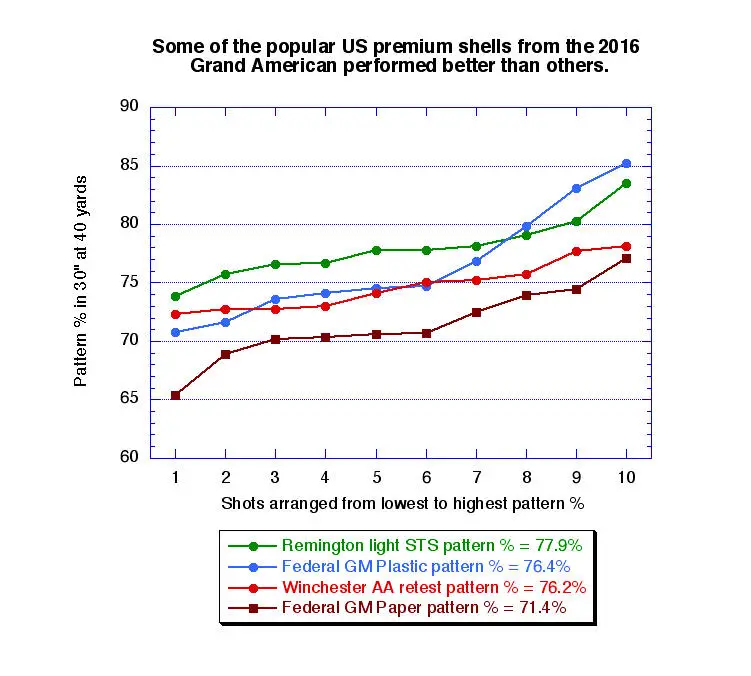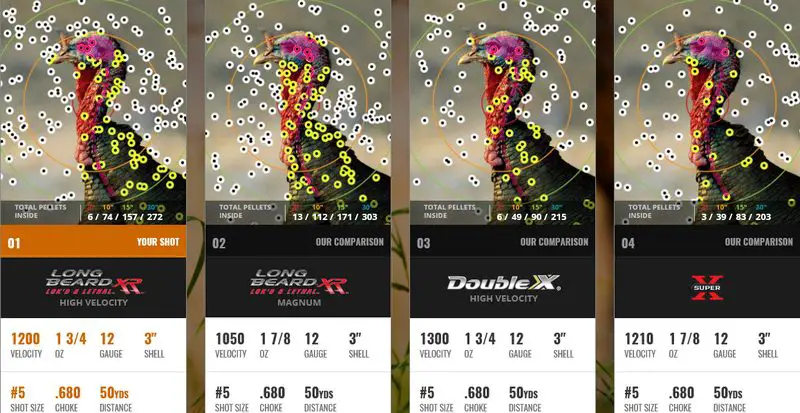The Case for Tighter Constriction Chokes
You'll find many experienced shooters that use tighter constriction chokes than others: have you wondered what the basis for this is?
The issue is the shotshells themselves. While shotshell pattern efficiency has improved over the years, it is hardly consistent. Consider this test by Neil Winston, comparing premium target loads.

You happen to be shooting trap and your choke tube is marked “Full.” Well, that must mean something? You are also using premium target shells, not the cheap promo stuff. What could the difference be? After all, for years you've heard all kinds of folks recommending what choke to use, without having a clue what you are using it for, and equally clueless about the specific shotshell you are using. But, you might hear someone screech “Use Light Modified!” anyway.
Your allegedly “Full Choke” with “Premium Target Ammunition” might throw a 65% pattern, or it might throw an 85% pattern. That's only with a 10 shot sampling, which is right at 90 rounds short of 100 straight. With cheap, soft, poorly-screened or non-screened shot that is more like gravel than a sphere, the variations get worse . . . far worse. Yet, these are all well-accepted as very good shotshells and they are. With a 5 shot test string, which patterns are you tabulating, the best, the worst, or somewhere in-between? Where in-between, exactly?
The Remington STS shell is a good shell, but the very next shell you fire may have 10% less pattern efficiency, or more. Shell performance varies from lot to lot as well. One Federal Gold Medal threw an 85% pattern, but another threw a 71% pattern. Pattern variations of 20 – 25% are not unusual at all in cheaper loads. Yet, 20 points of pattern percentage is the difference between “Improved Cylinder” performance and “Full Choke” performance. Do you really believe that someone who gushes that you should use “Light Modified” in your gun with your ammo knows what pattern efficiency it produces with your shell and your gun?
PROPERTIES OF LEAD PELLETS and PATTERNS
Shotgun patterns have been studied relentlessly for over 150 years. We know:
Lead pellets are not perfect spheres in the first place
Lead is subject to deformation
Individual pellets behave randomly, as individuals
No two patterns are identical
Shot string has no significant effect on pattern density (6% or less @ 50 yards, direct crossing shot) as proved by Ed Lowry
Struggling to compare pattern evenness and searching for holes in a pattern is a worthless endeavor
Shotshell materials and design has just as much an effect on patterns as chokes do. You need both a quality choke and a quality shell to get top performance.

What
puts over 100 #5 lead pellets in a 10 inch circle at 50 yards?
Not
many 3 inch twelve gauge shells can do that, not even close. A Super-X
1-7/8 oz. shell may manage 39 pellets, yet a Longbeard XR 1-7/8 oz.
1050 fps load can do 112.
It
doesn't take much walking the trap or skeet field to find "lost birds"
with one or two pellet holes in them that did not break. You can easily
find clays with 3 holes in them as well, but you won't find many
unbroken clays with four holes in them. If you want close to a certain
break, you need to hit a clay pigeon with four pellets. If you want a
quickly dead pheasant, mallard, or similar: you need four pellets in
the torso as well. The ease of breaking clay pigeons varies by
temperature, brand of clay, and individual lot of clay. Knowing this is
of little practical value, for what lot did that clay you are shooting
at come from, anyway, and is it harder or easier to break, and by how
much?
What is the kill zone of a dove? How about a mallard that was called in with the group, but is now flying directly away from you with only the head and neck exposed for an instant, lifeless drop?
Pattern
efficiency is where all shotgun performance comes from. For 16 yard
trap, a good starting point for choke constriction is .022 inch. For 27
yard trap, .032 inch. However, that is based on high quality 1-1/8 oz.
shells: if you want to drop the payload or the shot hardness and
sphericity, all bets are off, it is just starting over. High velocity
tends to open patterns a bit, and that is true of hunting lead and
steel loads as well.
What
specifically is going on with one specific shotgun, at at one specific
range, with one specific shell, at one specific altitude, with one
specific choke tube is unknowable . .. unless we pattern our own
shotguns to find out.
Copyright 2017 by Randy Wakeman. All Rights Reserved.












